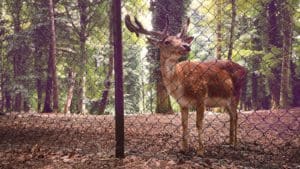
Deer fencing has different functions. It can be used to maintain different deer densities in close proximity to each other. It can also partially or completely exclude deer from particular areas to prevent public safety hazards or to meet environmental, agricultural, or forestry requirements. High deer high fences can also enclose deer in specific areas such as farms or parks.
Here are some best practices to consider before, during, and after deer high fence installation.
Consider all options available. Evaluate deer high fence options in terms of the type of fence required, materials used, cost-effectiveness, practicality, and impact.
Fence types
The minimum specifications for deer fences are as follows:
| Species | Mesh Size (mm) | Height (m) |
| Roe | 200 x 150 | 1.2 |
| Fallow | 220 x 200 | 1.5 |
| Red/Sika | 220 x 300 | 1.8 |
Where appropriate, construct the high fence in such a way that any deer can escape the enclosure through deer-leaps or simple one-way gates.
Electric fencing systems may be suitable, although deer species react to electric shocks differently. Red deer and roe deer are most and least susceptible, respectively. A single electric high fence built to the recommended height prevents deer from passing, while two parallel fences running a meter apart stop deer from jumping.
Note that electric fencing may have high initial costs and constant electricity charges.
Study the cost implications
This is dependent on the kind of fence to be used, how easy or hard it is to set up, and how long should the fence be in place.
- Confirm if it is necessary to exclude deer from, or confine deer in, the fenced area.
- Do a cost-benefit analysis of using alternative deer management methods, such as culling deer, diversionary feeding, or individual tree protection.
- Take into account indirect costs such as high fence maintenance, removal, or replacement.
- Consider whether the high fence should be a temporary or a permanent fixture.
Think about the practicality of high fence installation
Will snowfall or other weather conditions affect the effectiveness of the deer high fence? Is having a high fence worth the upkeep it will entail?
Review the potential impacts and plan accordingly
Assess the impacts of the deer high fence installation in terms of public safety, deer welfare, biodiversity, landscape, and cultural heritage and access. If there are repercussions that cannot be reduced through good fence design and siting, consider an alternative solution if possible.
- Consult with relevant government agencies during the planning stage of any high fence installation which may affect deer movement.
- Make sure the high fence is inspected and maintained regularly to remain visible and deer-proof.
- If one side of the road where deer usually cross is being fenced, see if the increased threat to road users is acceptable. If not, divert deer to a safer area; note that this may require additional fencing.
- Make sure the high fence does not channel/funnel deer into less visible areas.
- Plan and construct the high fence in such a way that it does not alter existing sightlines.
- Find out if there’s a need to install traffic-warning signs at all the points where deer will cross once a new fence is constructed.
- Ensure that the health of deer dependent on the fenced area for food or shelter remains the same.
- Continuously monitor the area so that any impacts are quickly identified and resolved.
Straight Shooter Game Fencing works with property owners throughout the US to provide the best deer high fence installation at competitive prices. We guarantee a professional fencing installation on your property no matter the size. No job is too big or too small and no terrain is too rough. Get in touch with us to know more.
